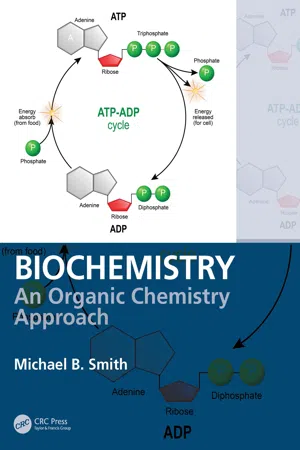Chemistry
Esters
Esters are organic compounds formed by the reaction between carboxylic acids and alcohols. They are known for their pleasant, fruity odors and are commonly used in flavorings, fragrances, and as solvents. Esters also play a role in biochemistry as they are found in fats and oils, and are important in the formation of lipids.
Written by Perlego with AI-assistance
3 Key excerpts on "Esters"
Learn about this page
Index pages curate the most relevant extracts from our library of academic textbooks. They’ve been created using an in-house natural language model (NLM), each adding context and meaning to key research topics.
- eBook - ePub
Biochemistry
An Organic Chemistry Approach
- Michael B. Smith(Author)
- 2020(Publication Date)
- CRC Press(Publisher)
8 LipidsLipids are organic compounds such as fatty acids or natural oils, waxes, and steroids that are insoluble in water but soluble in organic solvents. Fatty acids are components of triglycerides and the hydrolysis of triglycerides is important for energy conversion in living systems. Lipids are important for the formation of lipid bilayers and the chemistry of Esters is important to the discussion of lipids.8.1 Carboxylic Acids and Esters
An important functional group has a carbon atom (alkyl group) attached to a carbonyl (C=O) functional group, but a hydroxyl (OH) group is also attached to the carbonyl carbon. This unit is known as a carboxyl group , also written as —COOH or —CO2 H, and it is the major structural feature of the class of organic molecules known as carboxylic acids . This structural arrangement is shown in the box on ethanoic acid (the common name is acetic acid; Figure 8.1 ). The polarization induced by the electronegative carboxyl oxygen makes the carboxyl carbon atom positive, which leads to the oxygen of the O—H unit being negatively polarized, and the hydrogen positively polarize; i.e., the proton is acidic. The O—H proton of a carboxylic acid is much stronger (pK a 1–5) than the O—H proton of an alcohol (pK a 16–18).FIGURE 8.1 Ethanoic acid.Fatty acids are long-chain carboxylic acids, and there are several classes. Certain terminology can be used, particularly for fatty acids that are found in nature. The carboxylic acid end is polar, associated with water solubility, and is labeled the delta (Δ) end of the fatty acid. The methyl end is associated with being nonpolar, more soluble in oils, and is labeled the omega (Ω) end of the fatty acid.The so-called essential fatty acids are those required in the diet because they cannot be synthesized by human cells. Common naturally occurring fatty acids include the C14 acid (myristic acid), the C16 acid (palmitic acid), the C18 acid (stearic acid), and the C20 - eBook - ePub
Biobased Lubricants and Greases
Technology and Products
- Lou Honary, Erwin Richter(Authors)
- 2011(Publication Date)
- Wiley(Publisher)
When the COOH group occurs at the end of a long hydrocarbon chain, the substance is referred to as a fatty acid. Fatty acids are components found mixed with the oils of oilseed plants and present problems in the formulation of biodiesel from these oils. Organic acids tend to be more corrosive than alcohols. Therefore, when oxidation occurs in a lubricant to form an organic acid, the resulting material is more detrimental to the device being lubricated.Another class of organic compounds essential to the biolubricants area is a class of compounds called Esters. An ester is formed when an organic alcohol reacts with an organic acid. Esters often have very pleasant aromas and are responsible for the “nose” in a glass of wine or the flavor of fruits and vegetables. Wintergreen, for example, is an ester derived from methanol and salicylic acid. If one were to react ethanol with acetic acid, an ester would form (Figure 2.12 ). This compound called ethyl acetate (ethyl from the alcohol, acetate from the acid) is used as a solvent to remove finger nail polish. HOH (water) is lost when an acid and an alcohol react together. This is an important observation. Whenever an ester is formed from an acid and an alcohol, water is the byproduct of the reaction. The entire reaction can be reversed in that water can be added to an ester to regenerate the original acid and alcohol.One of the components of biodiesel fuel is methyl oleate. The material is an ester that is formed when methanol is reacted with oleic acid.Figure 2.12 Ethyl acetateIf the -OH group is removed from methanol and the -H is removed from the oxygen atom at the end of the oleic acid molecule and then joined together, water (HOH) is formed. The other substance formed in the same reaction is methyl oleate (Figure 2.13 ) where the -CH3 - eBook - ePub
- Sue Clarke(Author)
- 2009(Publication Date)
- Churchill Livingstone(Publisher)
aromaticity derives from this fact. While in colloquial terms ‘aromatic’ is commonly applied to describe strongly fragrant compounds, in chemical technical terminology it refers purely to the possession of this type of chemical structure, irrespective of the fragrance (which in practice may not be at all what we mean colloquially by aromatic).FUNCTIONAL GROUPS
Compounds made up of only hydrogen and carbon are called hydrocarbons . They make up only a small number of the total organic compounds.When looking at an organic molecule we find that only certain parts and bonds take part in the chemical reactions. Usually the carbon chain or skeleton remains unchanged. The atom or group of atoms that defines the chemical reactivity of a particular class of organic compounds and determines its properties is called the functional group . Commonly occurring functional groups are alkenes (hydrocarbons with double bonds), alcohols, aldehydes, ketones, carboxylic acids and Esters.AROMAFACT
The functional group names can be used in characterizing and describing the odours of many perfumes and some of the essential oils. Aldehydic smelling oils are due to compounds with functional groups called aldehydes, and sweet and fruity smelling oils are due to compounds with functional groups called Esters.A large amount of organic chemistry is concerned with the reactions and transformations of one functional group to another. An understanding of the functional group explains the particular set of properties associated with compounds within a series or ‘family’.HOMOLOGOUS SERIES
These are useful arrangements of compounds into ‘families’ and are very common in organic chemistry and biochemistry. Members of homologous series have a number of characteristics in common.1 They all have the same general formula.2 They have similar properties, both physical and chemical, i.e. they have the same functional group.This can be simply illustrated with the alkanes , which are saturated noncyclic hydrocarbons. They all have the same general formula, Cn H2n +2, where n


